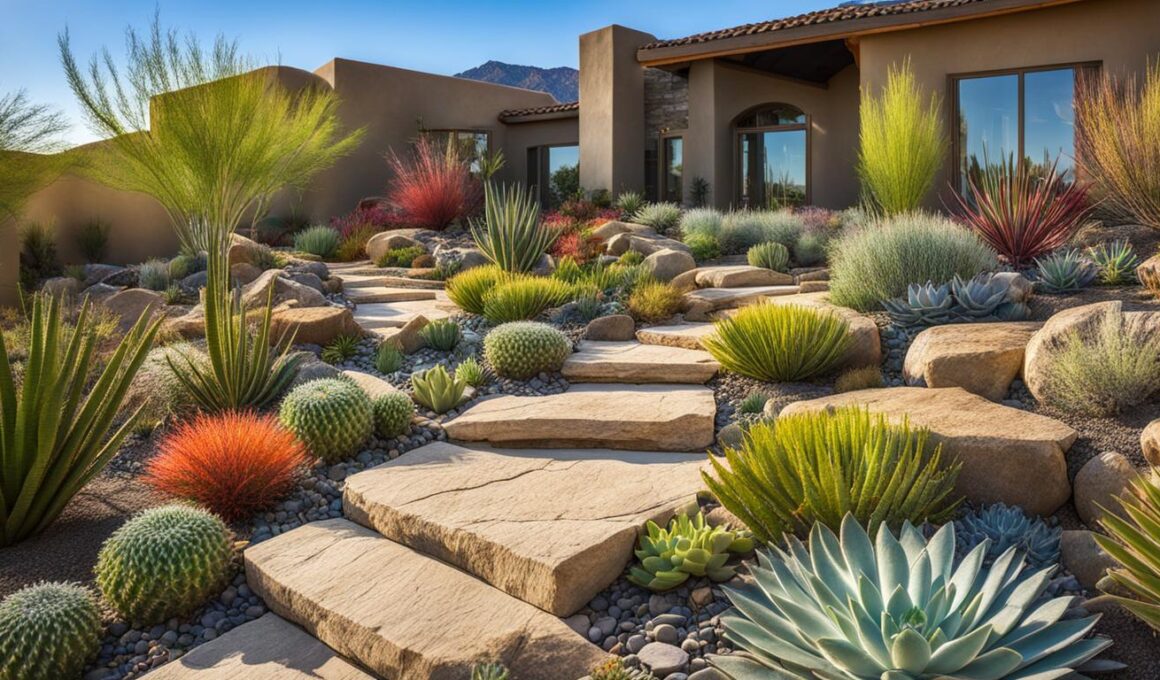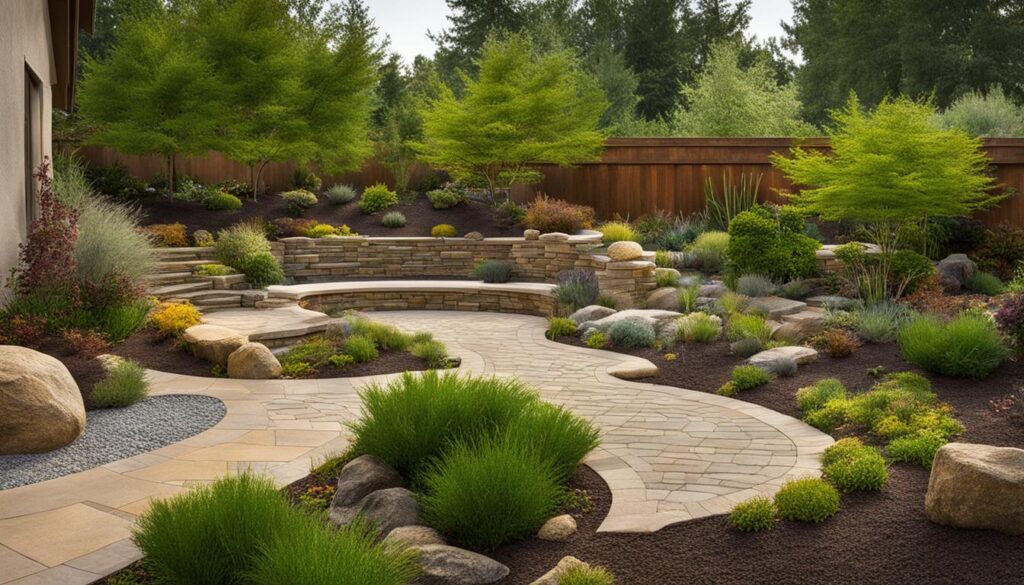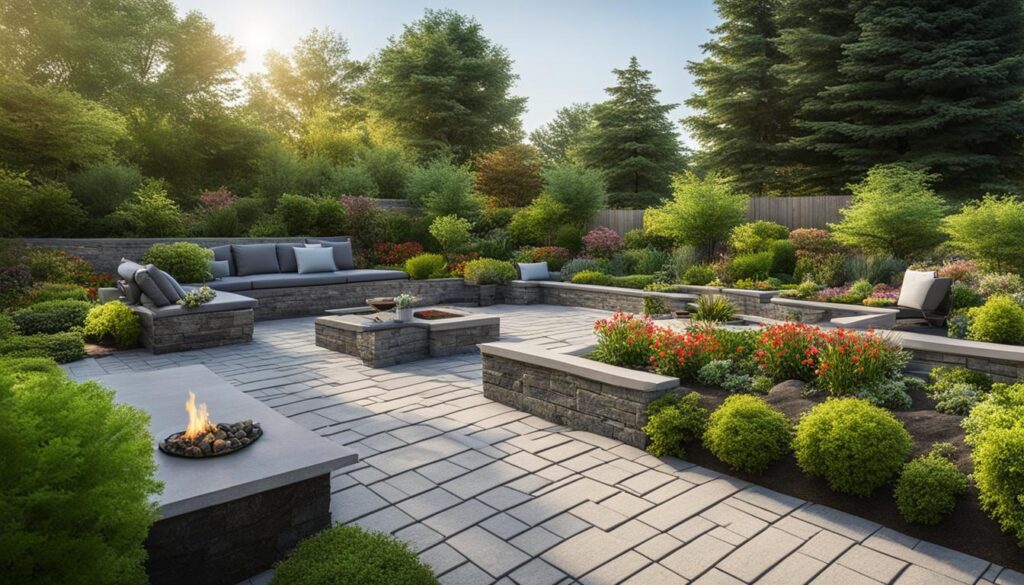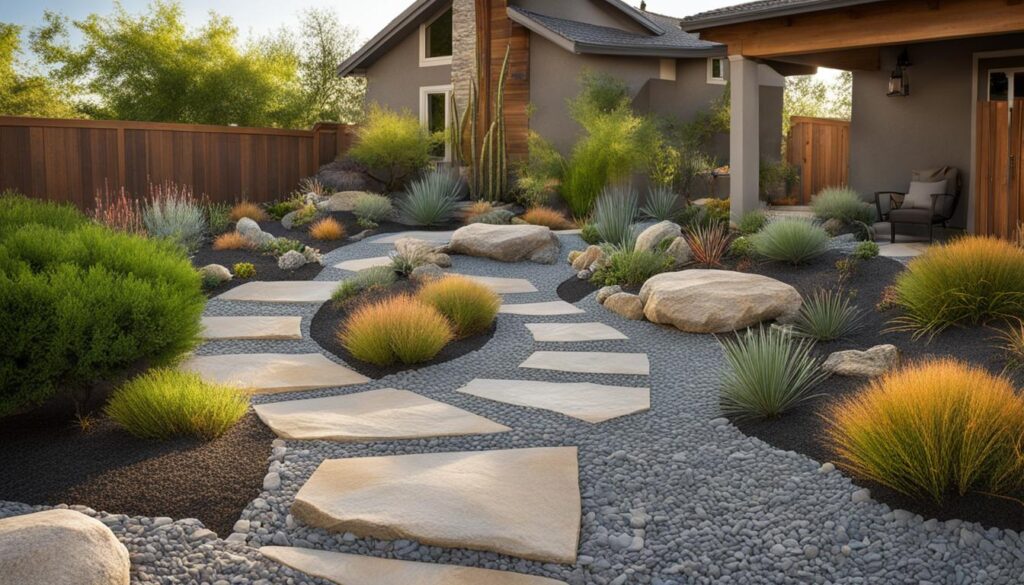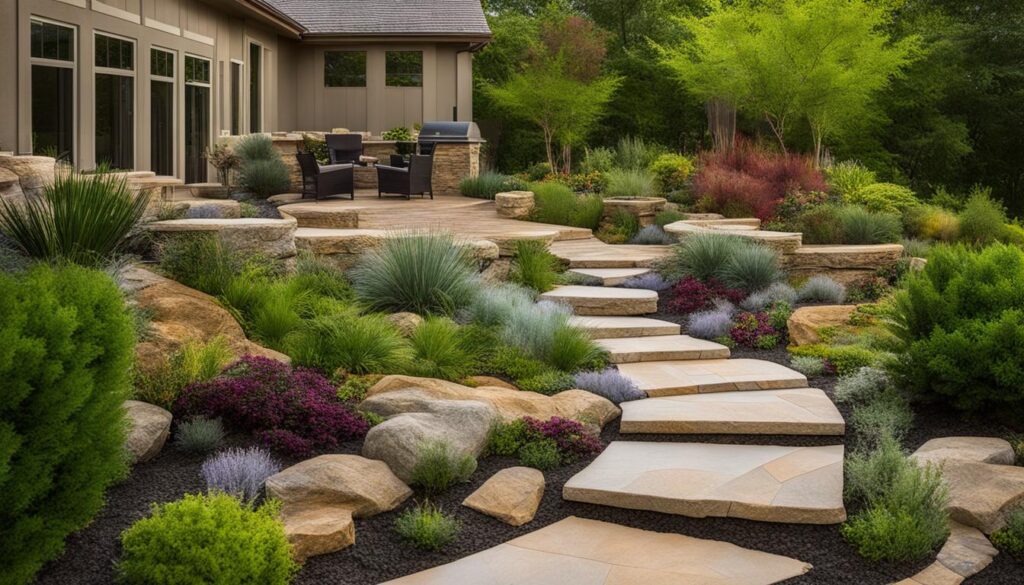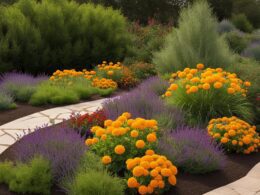Enhance the functionality and visual appeal of your outdoor space by incorporating hardscaping into your xeriscape design. Adding hardscape elements such as patios, pathways, and water features can transform your landscape into a stunning and sustainable oasis. In this section, we will guide you through the steps to seamlessly integrate hardscape elements into your xeriscape design.
Key Takeaways:
- Incorporating hardscape elements can elevate the functionality and visual appeal of your xeriscape design.
- Assess your outdoor space and identify your needs and desires before incorporating hardscape elements.
- Set a budget to ensure your hardscaping project aligns with your financial resources.
- Research different hardscape elements and materials to discover their versatility.
- Create a design plan that integrates both hardscaping and existing softscape elements.
Assessing Your Space and Needs
Before incorporating hardscaping into your xeriscape design, it’s essential to assess your outdoor space and identify your needs and desires. Start by considering the size and shape of your yard and take note of any existing plantings or features that you want to work around or incorporate into your hardscape design.
Next, think about how you envision using your outdoor space. Are you looking to create a cozy area for entertaining guests, a peaceful retreat for relaxation, or a functional space for gardening activities? Determining your intended use will help guide your hardscape design decisions.
Remember to consider the practical aspects of your space as well. Take note of any areas that receive more or less sunlight, as this will impact your choice of plantings and the placement of hardscape elements. Additionally, consider any drainage issues or slopes that may need to be addressed in your design plan.
Assessing your space and needs is a crucial first step in incorporating hardscaping into your xeriscape design. By understanding the unique characteristics of your outdoor area and identifying your desired functionality, you can create a hardscape design that seamlessly integrates with your existing landscape and enhances your outdoor living experience.
Once you have assessed your space and needs, you can move forward with confidence to the next step of your hardscaping journey: setting a budget. By establishing a clear budget, you can ensure that your design plans align with your financial resources and make informed choices when selecting materials and features for your xeriscape hardscape.
Continue reading to learn more about setting a budget for your hardscaping project and exploring the various hardscape elements that could transform your outdoor space into a captivating oasis.
Setting a Budget
Incorporating hardscaping elements into your xeriscape design requires careful consideration of your budget. Determining the cost of materials and labor is essential to ensure that your project aligns with your financial resources. By setting a budget, you can make informed decisions and prioritize elements that fit within your means.
When establishing your budget, take into account the cost of materials needed for your hardscaping project. Whether you choose natural stone, wood, concrete, or other materials, their prices can vary significantly. Researching the cost of different materials will help you make choices that best suit your budget and desired aesthetic.
Additionally, factor in the cost of labor when setting your budget. Depending on the complexity of your hardscaping design, hiring professionals such as contractors, designers, or architects may be necessary. Be sure to obtain quotes from different professionals to compare prices and find the best fit for your budget and project requirements.
Remember to leave some room in your budget for unexpected expenses that may arise during the course of your project. It’s always better to have a buffer in case of unforeseen circumstances or changes to your original plan. By carefully considering your budget and allocating funds accordingly, you can successfully incorporate hardscaping into your xeriscape design without breaking the bank.
Researching Hardscape Elements
When it comes to incorporating hardscape elements into your xeriscape design, there are a wide variety of options to choose from. Familiarizing yourself with these elements and their characteristics will allow you to make informed decisions and create a visually appealing and functional outdoor space.
One of the key aspects to consider is the versatility of hardscape materials. From stone to wood, concrete to metal, each material brings its own unique qualities to the design. Stone, for example, can add a natural and rustic charm, while concrete offers durability and a modern aesthetic. Take the time to explore the different materials and their suitability for your specific project.
Exploring Various Hardscape Elements
- Patios: Create an inviting outdoor living area that serves as an extension of your home.
- Pathways: Enhance the flow and accessibility of your landscape design with well-designed pathways.
- Retaining walls: Add structure and visual interest while addressing elevation changes in your yard.
- Water features: Incorporate the soothing sound of water and create a focal point in your outdoor space.
- Decking: Provide a versatile and functional surface for outdoor seating and entertainment areas.
- Pergolas: Add shade, privacy, and architectural interest to your garden or patio.
- Outdoor kitchens: Take your entertaining to the next level with a fully equipped outdoor cooking area.
By researching and understanding the various hardscape elements available, you can select those that best suit your design vision, desired functionality, and budget. Utilizing these elements in your xeriscape design will not only enhance the aesthetic appeal of your outdoor space, but also provide you with a durable and low-maintenance landscape solution.
Creating a Design Plan
Creating a well-thought-out design plan is essential when incorporating hardscaping elements into your xeriscape design. It ensures that your outdoor space is not only aesthetically pleasing but also functional and cohesive. Here are some steps to guide you in creating an effective design plan:
1. Consider Your Overall Vision
Start by considering the overall vision and aesthetic you want to achieve in your outdoor space. Do you prefer a modern or traditional design? Are you looking for a serene and tranquil atmosphere or a vibrant and lively one? Understanding your preferences will help you choose elements that align with your style and create a harmonious outdoor environment.
2. Integrate Hardscape and Softscape
When designing your outdoor space, it’s important to integrate hardscape and softscape elements seamlessly. The hardscape, which includes features like patios, pathways, and retaining walls, should complement the softscape, which consists of plants, trees, and flowers. Strive for a balanced blend of both, taking into consideration the scale, texture, and color of each element.
Remember, hardscaping should enhance the natural beauty of your outdoor space, not overpower it.
3. Sketch and Layout
Once you have a clear vision and have integrated the hardscape and softscape elements, it’s time to sketch and create a layout of your design. Consider factors such as traffic flow, accessibility to various areas, and focal points within your outdoor space. This will help you optimize the functionality and visual appeal of your design.
- Use graph paper or design software to create a scaled drawing of your outdoor space.
- Experiment with different layouts and placements of hardscape elements.
- Consider the orientation of the sun and wind to ensure optimal use of your outdoor space throughout the day.
By creating a comprehensive design plan, you can effectively incorporate hardscaping elements into your xeriscape design, resulting in an outdoor space that is both beautiful and functional.
Seeking Professional Advice
When it comes to incorporating hardscape elements into your xeriscape design, seeking professional advice can provide invaluable expertise and guidance. Consulting with a landscape architect or hardscape contractor can help you refine your design plan and ensure its feasibility.
These professionals bring years of experience and technical knowledge to the table. They will consider factors such as drainage, soil conditions, and local building codes to ensure a successful hardscaping project. With their expertise, they can provide insights, recommendations, and creative solutions to elevate your design and maximize the functionality of your outdoor space.
“A landscape architect or hardscape contractor has the expertise to analyze your space, understand your vision, and craft a design that harmonizes with both the natural surroundings and your desired aesthetic. They can help you select the right hardscape elements, materials, and finishes to bring your vision to life.” – Jane Anderson, Landscape Architect
The Benefits of Professional Expertise
One of the key advantages of working with a landscape architect or hardscape contractor is their ability to take your ideas and translate them into a cohesive design. They have an eye for detail and can offer valuable insights into the best placement and arrangement of hardscape elements to enhance the flow and functionality of your outdoor space.
Additionally, professionals have access to a wide range of resources and materials, allowing them to source high-quality products and finishes for your hardscape design. They can guide you through the selection process, ensuring that the chosen materials not only align with your vision but also withstand the test of time, weather conditions, and regular use.
So, whether you need assistance with conceptualizing your design, navigating the complexities of permits and regulations, or overseeing the construction process, partnering with a landscape architect or hardscape contractor is a wise investment. Their expertise will help you create a stunning hardscape that seamlessly integrates with your xeriscape design and elevates your outdoor living experience.
How Can Hardscape Features Enhance the Low-Maintenance Aspect of Xeriscape Designs?
Incorporating hardscape features such as gravel pathways, stone patios, and retaining walls can enhance the low-maintenance aspect of xeriscape designs. These lowmaintenance xeriscape design ideas help minimize the need for watering and upkeep while adding visual interest and functionality to the landscape.
Conclusion
Incorporating hardscaping into your xeriscape design can transform your outdoor space into a harmonious and functional haven. By combining the soft elements of plants and flowers with the hard elements of stone, wood, or concrete, you can create a balanced and captivating landscape that reflects your personal style and provides year-round enjoyment.
With the help of professional expertise, the possibilities for creative hardscape design are endless, allowing you to craft a unique and inviting outdoor oasis. Consulting with a landscape architect or hardscape contractor can provide valuable insights, recommendations, and technical knowledge to refine your design plan and ensure its feasibility.
Whether you envision a serene patio retreat, a vibrant garden pathway, or a stunning water feature, incorporating hardscape elements into your xeriscape design offers both aesthetic appeal and practical functionality. Embrace the versatility of hardscape elements and materials, and create a design plan that seamlessly integrates both hardscape and softscape elements. Take the first step towards transforming your outdoor space and enjoy the benefits of a beautifully designed xeriscape with incorporated hardscape elements.





